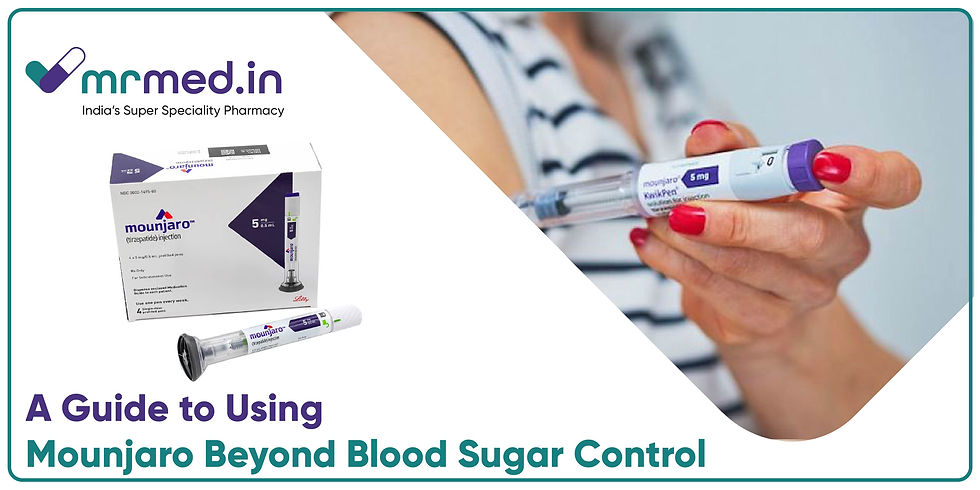The Future of Diabetes Care: How Close Are We to Curing Type 1 Diabetes?
- Healthcare Tips

- Sep 12
- 4 min read

For decades, researchers have been working to unlock the mysteries of Type 1 Diabetes. Unlike Type 2, which is often related to lifestyle and diet, Type 1 is an autoimmune condition where the body attacks insulin-producing cells. This means patients must rely on insulin therapy or devices to control their blood sugar. But science is moving rapidly, and promising new treatments are giving hope that a functional cure may be closer than ever before. With breakthroughs in medicines, technology, and research into stem cells, the future of diabetes care looks more hopeful than in any previous generation.
Can Type 1 Diabetes Really Be Cured in the Future?
Currently, there is no permanent cure for Type 1 Diabetes, but scientists are exploring multiple approaches. One area of research focuses on stem cell therapy, where new insulin-producing cells can be created and implanted. Early trials show promising results in restoring insulin production, though long-term effectiveness is still under study.
Another path involves immune system therapies that try to stop the body from attacking its own pancreas. These treatments may protect remaining healthy cells and delay the worsening of the condition. While these are still in clinical stages, they provide real hope that future generations may not have to depend on lifelong insulin therapy.
At the same time, advancements in injectable medicines such as Tirzepatide and devices like smart insulin pumps are improving the quality of life. These tools may not replace a cure, but they make day-to-day management more reliable and less stressful.
What Are the Latest Advances in Diabetes Treatment?
Over the past few years, new medicines and therapies have been developed to support people living with Diabetes. Among them, GLP-1 receptor agonists and dual-action medicines are gaining attention.
Some of the latest developments include:
Mounjaro Kwikpen use: This device delivers Tirzepatide, a dual-acting medicine that supports both blood sugar control and weight management. Though more studied in Type 2, its mechanisms provide insights that may benefit Type 1 research.
trulicity injection: Based on the medicine Dulaglutide, this therapy improves blood sugar control and supports patients in maintaining consistent levels.
Advanced insulin delivery systems: Smart pumps and continuous glucose monitoring (CGM) devices reduce the burden of frequent checks and injections.
Artificial pancreas technology: Combines a pump and sensor to automatically balance insulin levels, reducing risks of high or low sugar.
These advances are steps toward creating a bridge between current treatments and a long-term cure.
How Do Lifestyle Changes Support Diabetes Management?
Even with medical treatments, daily habits play a huge role in managing Type 1 Diabetes effectively. A structured Diabetes Diet and regular exercise support stable blood sugar levels and reduce the risk of complications.
Important lifestyle tips include:
Balanced meals: Focus on whole grains, vegetables, lean proteins, and limited refined sugar.
Regular activity: Helps improve insulin sensitivity and supports better glucose control.
Monitoring patterns: Keeping track of sugar levels helps adjust food and medicine intake.
Stress management: Stress hormones can raise blood sugar, so relaxation practices are valuable.
Adequate sleep: Supports hormonal balance and energy regulation.
While lifestyle cannot cure the condition, combining these steps with medicines such as Dulaglutide or Tirzepatide helps patients manage symptoms better. It makes treatment more effective and lowers the risk of long-term complications.
What Are the Best Approaches to Managing Diabetes Today?
Managing Type 1 Diabetes requires a combination of medical treatments, monitoring, and daily self-care. Doctors now recommend a personalised approach because each patient responds differently.
Best approaches include:
Insulin therapy: Still the foundation of treatment, but methods are becoming smarter with pumps and rapid-acting formulas.
Newer medications: Options like Tirzepatide and trulicity injection are being studied as add-on therapies.
Technology-driven care: CGM devices and smartphone-linked insulin pens help patients track data easily.
Structured education: Patients and families who learn about nutrition, medication, and emergency care tend to do better in the long term.
Holistic lifestyle care: Following a Diabetes Diet, exercising regularly, and mental well-being programs create stronger overall health.
Together, these strategies form the Best Approaches to Managing Diabetes, aiming to give patients more freedom and fewer complications in daily life.
How Soon Could a Cure Become a Reality?
Experts believe that while a complete cure may still take years, progress is happening faster than ever before. Several clinical trials on stem cell therapies, immune-modulating medications and advanced artificial pancreas devices are already showing encouraging results.
Key points about the timeline:
Short-term (next 5 years): More advanced medicines like Dulaglutide and Tirzepatide may improve overall management.
Medium-term (5–10 years): Artificial pancreas systems could become widely available, reducing manual intervention.
Long-term (10+ years): Stem cell and gene therapies may provide lasting solutions, potentially functioning as a cure.
While exact timing is uncertain, what’s clear is that patients today have far more options than before. With ongoing research, the gap between managing the disease and curing it is narrowing.
Final Thoughts
The journey toward curing Type 1 Diabetes is complex, but the future is brighter than ever. Breakthroughs in medicine, technology, and lifestyle-based care are already transforming lives. While we may not yet have a complete cure, today’s therapies are offering hope, stability, and a better quality of life for millions of people. The key lies in continuous research, patient awareness, and embracing the new tools science is making available.


Comments